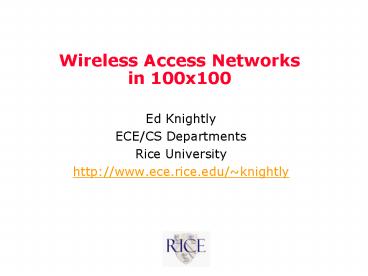Wireless Access Networks in 100x100 PowerPoint PPT Presentation
1 / 15
Title: Wireless Access Networks in 100x100
1
Wireless Access Networksin 100x100
- Ed Knightly
- ECE/CS Departments
- Rice University
- http//www.ece.rice.edu/knightly
2
Status of Residential Broadband
Source Analysys (April 2003)
3
And Still Growing
4
How Fast is Broadband?
- Average maximum download speed
- Cable 708 kb/sec
- DSL 467 kb/sec
- Report by comScore, 2003
5
Wireless Access Networks
- Issue fiber is not always cost effective to
deploy - Wireless promises widely deployed Internet access
to residences, hot spots, and public places - Goals
- High bandwidth
- High availability
- Large-scale deployment
- High reliability
- Nomadicity
- Economic viability
6
WiFi Hot Spots?
- 11 Mb/sec, free spectrum, inexpensive APs/NICs
Carriers Backbone/Internet
T1
Medium bandwidth (wire), sparse, and expensive
- Why? poor economics
- High costs of wired infrastructure (10k
500/month) - Pricing U.S. 3 for 15 minutes CH 0.90
CHF/minute - Dismal coverage averaging 0.6 km2 per 50 metro
areas projected by 2005
7
Cellular?
- Cellular towers are indeed ubiquitous
- Coverage, mobility,
- High bandwidth is elusive
- Aggregate bandwidths in Mb/sec range, per-user
bandwidths at dial-up speeds - Expensive spectral fees and high infrastructure
costs
8
Two Architectures
- Multi-hop Wireless
- Wireless back-haul network
- One-hop Wireless
- Fiber to the neighborhood
- Pole-top wireless
- Issue cost of deployment vs. bandwidth
9
TAPs Multihop Wireless Infrastructure
- Transit Access Points (TAPs) are APs with
- MIMO/beam forming antennas
- multiple air interfaces
- enhanced MAC/scheduling/routing protocols
- Form wireless backbone with limited wired
gateways
10
TAPs Multihop Wireless Infrastructure
- Transit Access Points (TAPs) are APs with
- MIMO/beam forming antennas
- multiple air interfaces
- enhanced MAC/scheduling/routing protocols
- Form wireless backbone with limited wired
gateways
- High bandwidth
- High spatial reuse and capacity scaling
- Opportunistic protocols
- High availability
- Redundant paths and non-mobile infrastructure
- Deployability
- Good economics
- Unlicensed spectrum, few wires, exploit WiFi
components
11
Key Multi-Hop Challenges
- Multi-hop Wireless Architecture
- low infrastructure costs (few wires/free
spectrum) - Scale system capacity
- APs will need to forward traffic to wires
- Medium access and protocol design
- distributed opportunistic protocol design
- exploit unique network architecture
- Secure and DoS-resilient protocol design
- Proof-of-concept prototypes and testbeds
12
One-Hop Wireless
- Fiber-to-the-neighborhood and one-hop wireless
- Differences with cellular
- No mobility
- Near symmetry of devices
- Both sides can have antenna arrays
- Neither side is battery powered
- Unlicensed spectrum
- Goal 100x100
- Challenges
- Most of multi-hop plus optimizations for one-hop
13
Prototype and Testbed Deployment
- FPGA implementation of enhanced opportunistic,
beamforming, multi-channel, QoS MAC - Build prototypes and deploy on Rice campus and
nearby neighborhoods - Measurement study from channel conditions to
traffic patterns
14
Inter-disciplinary Collaborations
- PHY-Hardware
- Protocols (all layers)
- Economics
- Where is the wireless/fiber boundry
- Distance fiber cost vs. wireless capacity
- Security
- What issues unique to wireless?
- New DoS-resilience challenges
15
Summary
- Status quo
- WiFi footprint is dismal
- Cellular is too slow
- TAPs
- Reduce backhaul cost with a multi-hop
infrastructure - One-hop wireless
- Increased bandwidth with FTT Neighborhood
- Inter-disciplinary challenges abound
- Wireless architectures
- Protocol design and analysis
- Distributed, scalable, secure,

